Dry-garden lushness: Linda Peterson’s San Antonio garden
Rooftop view of the walled courtyard and front garden. Not a blade of lawn grass anywhere, nor is it missed.
Seeing one of my new favorite gardens requires an hour-and-a-half road trip to San Antonio, but it’s worth every trafficky mile. Linda Peterson, whose dreamy garden I visited last September, invited a few friends over for tea after the San Antonio Watersaver Tour, and I was delighted to be included. Seeing Linda and her beautiful garden again in a different season, plus sitting down to a delicious high tea served by her charming daughters? Yes, please!
Courtyard Garden
Linda’s gray-green stucco home wraps around a large courtyard garden thanks to walls painted the same color. Linda and her husband built their home toward the rear of the property in order to preserve several sprawling, magnificent live oaks. The walls provide back-yard-style enclosure and privacy, and a generous stone patio and curving paths create seating areas and lead you through the space.
Linda led us up to her home’s flat roof via a spiral staircase so we could take in a bird’s-eye view. The perspective allows full appreciation of Linda’s planting style: massed groundcovers and shrubs, carefully pruned to show off their architectural forms. For example, the soap aloes (Aloe maculata) blooming at lower left are kept tidy by pulling out pups (baby aloes) from around their spiny leaves, leaving star-shaped solitary plants massed in a winding “aloe river.”
Panning right, you see a table and chairs in front of a focal-point fireplace, with wood stacked in niches on each side.
Back at ground level by the front door, a pair of metal rhinos greets visitors. Against the green walls of the house, the coral flowers of the soap aloes stand out nicely. The chartreuse groundcover in front may be Mexican sedum.
Agave weberi and prickly pear add year-round structure around a pot-style fountain.
Turning around, here’s what you see as you enter the courtyard.
Real and faux cacti mingle in a bed along the wall.
Succulent wreath on the fireplace
The long view from the fireplace seating. Don’t you just want to lie in that hammock all day?
And now we’ve circled back around to the rhinos. The swoosh of gray river stones is a nice touch, don’t you think? It looks like a stream the animals are about to cross.
Another view of the soap aloes, plus a wavy-armed variegated American agave
Linda collects metal and stone animals to adorn her home and garden. I don’t remember seeing this little armadillo last time I visited.
Linda is disciplined with her color choices, sticking with soft gray-green, ivory, and lavender with occasional pops of yellow. This purplish pink bougainvillea was, perhaps, the brightest hue in her garden.
It grows atop the arbor, offering cheery welcome to visitors.
Front Garden, Right of Front Walk
Winding paths lead both left and right into the front garden from the main walk. Turning to the right, a flagstone path widens into a small patio with a simple wooden bench, perfect for stopping to take in the view. Feathery bamboo muhly (Muhlenbergia dumosa) hides the next-door driveway, and a low cluster of lantana blooms frothily.
Most lantanas have hot-colored flowers: orange, red, gold. These have white-and-pale-yellow flowers that fit nicely into Linda’s restrained color scheme.
Another view. Notice how the gray-green flagstone harmonizes with the house/wall color and the cool colors overall. Details like these give Linda’s garden cohesiveness.
A wider view from the end of the path reveals a mass planting of foxtail fern (Asparagus meyeri), whose foliage echoes the form of a nearby agave.
Three culvert-pipe planters along the foundation of the house elevate a collection of palms.
Front Garden, Left of Front Walk
Heading left from the front walk takes you past a large agave, flowering society garlic, and more foxtail fern.
Where the undulating arms of a live oak have been preserved via cut-outs in the stucco wall, a rustic picnic table provides a spot to pause and enjoy the scene.
Looking back toward the front walk and arbor, you see more soap aloes blooming. Linda has a lot of different plants, but she also repeats clusters of plants to great effect.
Continuing along the path, a silvery cassia (Senna phyllodinea) blooms in perhaps the sunniest part of Linda’s garden.
A closeup of the cassia flowers and flat, curled seedpods
And one more view of the silvery cassia, balanced with a large, architectural agave
Tucked among the plants, a stone crocodile planter filled with succulents grins like the cat who ate the canary.
A mystery plant with rich purple flowers. Anyone able to ID it? It’s cupflower, or Nierembergia scoparia ‘Purple Robe’. (Thanks, Gretchen, and Linda for confirming.)
One advantage of a gravel garden — Linda’s entire garden is mulched with tan pea gravel — is that it allows you to have open spaces, like the desert. Agaves and other dry-loving plants look very natural in a garden mulched with rock, and open space does too, allowing you to use fewer plants, if you wish. (In contrast, open spaces in a wood-mulched garden never look quite natural.)
Our native golden leadball (Leucaena retusa) displays its yellow pom-pom flowers alongside the driveway.
The flowers are eye-catching.
Another cluster of soap aloes, along with a nicely pruned prickly pear
Variegated American agaves catch shafts of light and seem to glow.
Rear & Side Garden
Alongside the driveway, a potted Arabian lilac (Vitex trifolia ‘Purpurea’) flashes leaves that are gray-green on top and lavender underneath. Potted drought-tolerant plants are a smart choice for a difficult spot with rocky or tree-rooty soil.
A back deck transitions between the house and the rear garden. I love Linda’s treatment of the deck skirting: sturdy wire (the same as on the trellis above) cloaked with fig ivy, which closely follows the wire’s grid pattern. At ground level, a swath of variegated flax lily (Dianella tasmanica ‘Variegata’) makes an easy-care groundcover that lights up the shade.
Here’s the view from the deck: a perforated metal lantern hanging from a tree, and a triangular faux-bois birdbath below. A Texas redbud effectively screens neighboring houses from view. Linda also strategically hangs pots of asparagus fern from the wire trellis to block undesirable views.
Back at ground level, a pruned-up hedge of variegated pittosporum turns these sometimes unwieldy shrubs into graceful small trees. Linda treats a number of her shrubs and woody perennials this way, including Texas sage (Leucophyllum frutescens) and rosemary, to great effect. It allows for air movement and visual openness, she explains. Foxtail fern adds feathery texture below.
An umbrella-shaded pair of rockers offers a pleasant spot to sit. Clumping bamboo softens the wooden privacy fence and provides extra privacy from neighboring houses.
The screen of bamboo continues, planted atop a curving berm that softens the back corner. More foxtail fern adds evergreen, fringey texture.
Even a work area at the back of the house is brightened with special touches, like green bottles upended on bamboo poles stuck in pots of ferns and (I think) agapanthus Neomarica caerulea ‘Regina’ (see lcp’s comment below).
On a back terrace, succulents are displayed in pots glazed blue and brown.
Thank you, Linda — and daughters Demi and Sam — for a very special afternoon! Click here to read about my visit to Linda’s garden last September, and here for Rock Rose’s post about the garden and tea party.
I welcome your comments. If you’re reading this in an email, click here to visit Digging and find the comment link at the end of each post.
_______________________
Digging Deeper: News and Upcoming Events
Come see me at Festival of Flowers in San Antonio, May 28, time TBA. Learn more about water-saving gardening during my talk at San Antonio’s 19th annual Festival of Flowers. Get a signed copy of my book after the talk. Tickets to the all-day festival, which includes a plant sale and exchange, speakers, and a flower show, are available at the door: $6 adults; children under 10 free. Free parking.

I’m on Instagram as pamdigging. See you there!
All material © 2006-2016 by Pam Penick for Digging. Unauthorized reproduction prohibited.


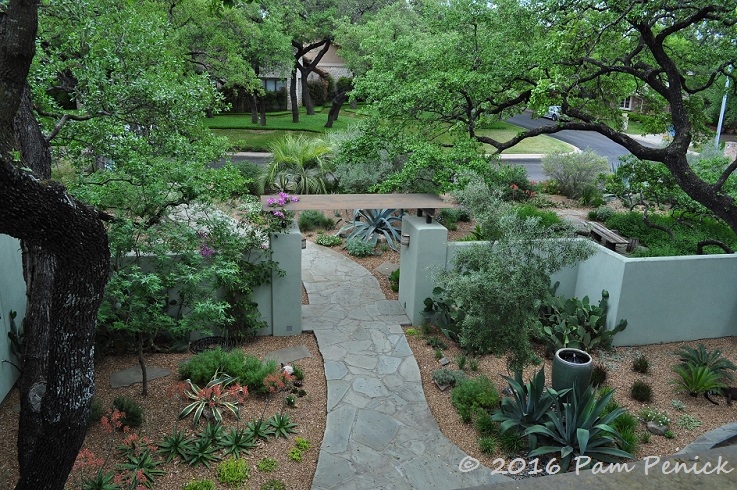
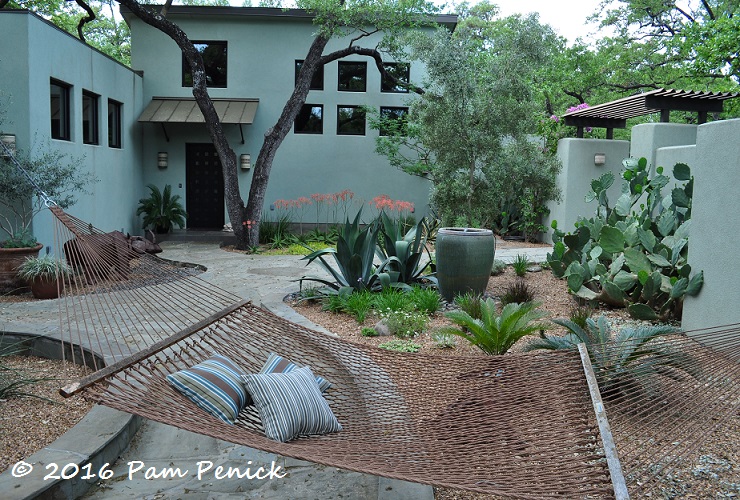
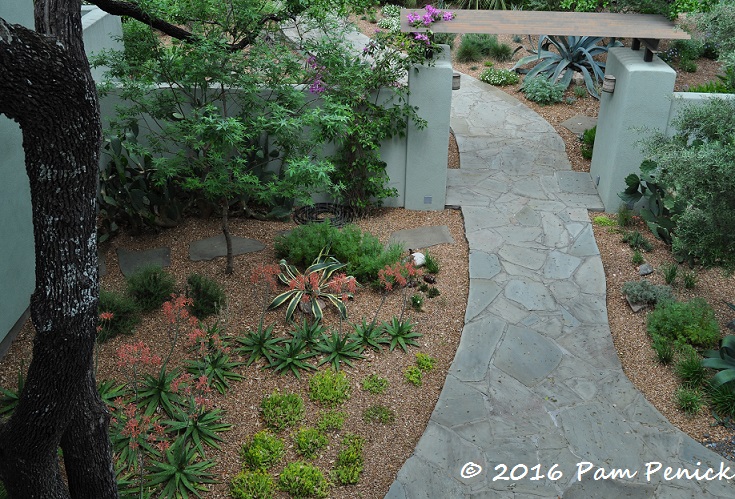
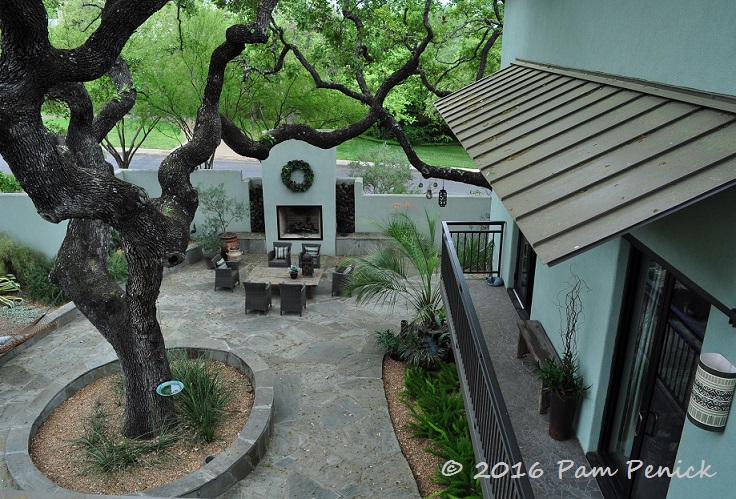
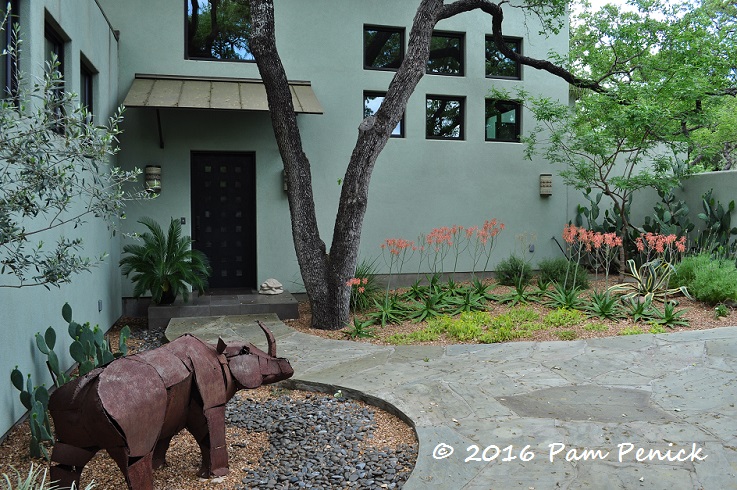
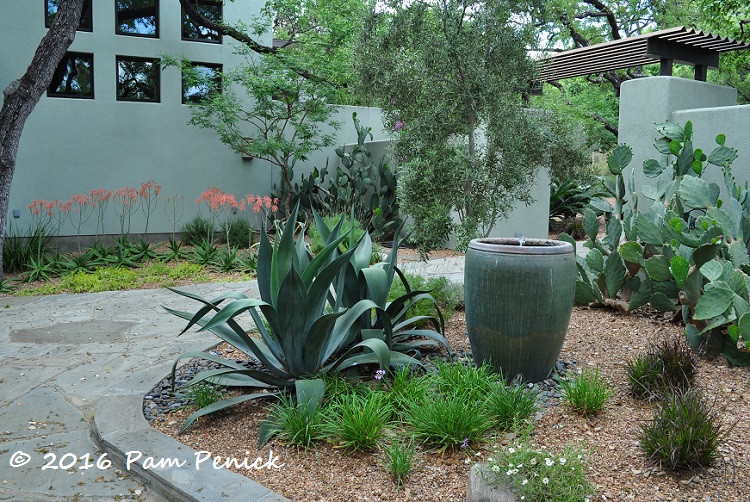
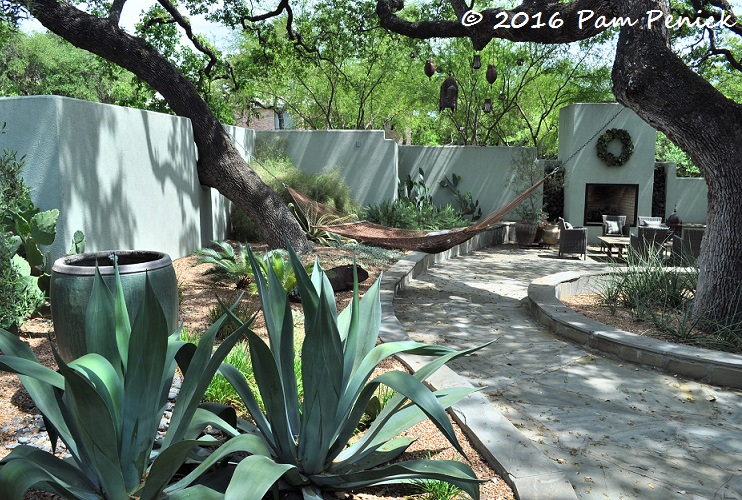
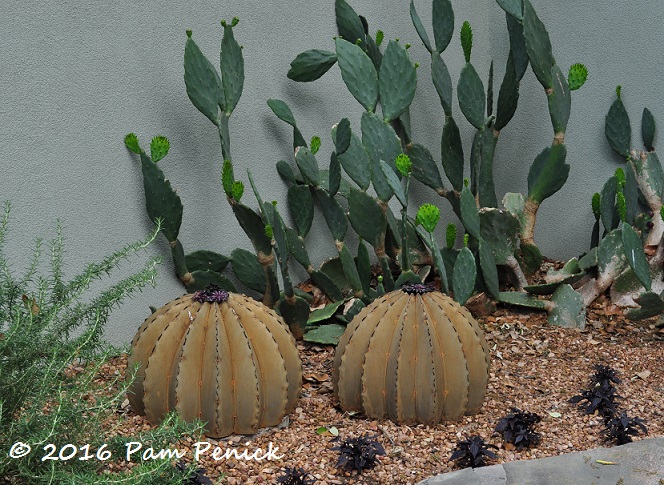

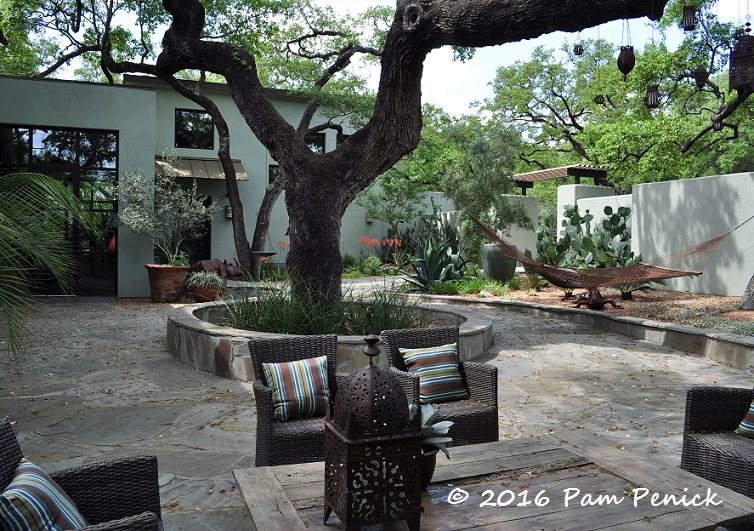
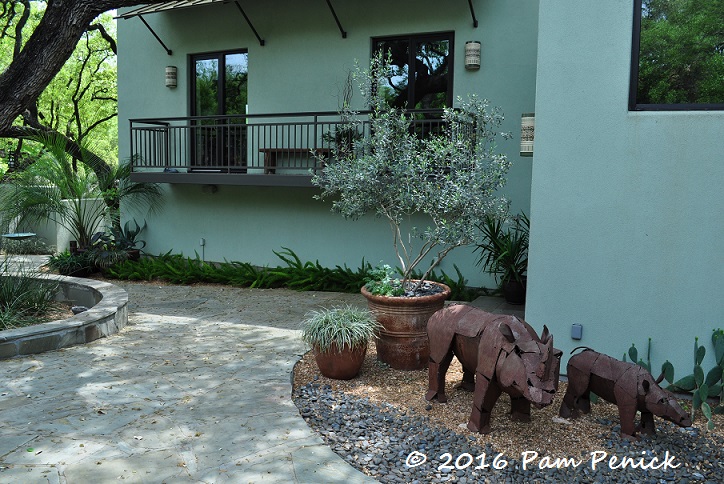
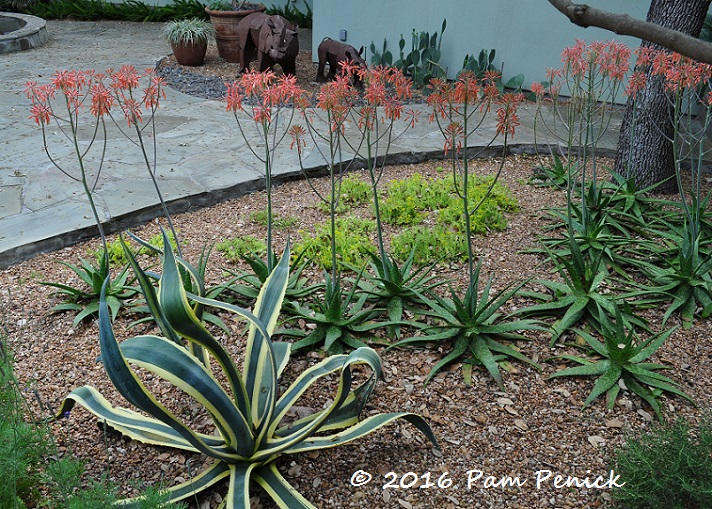
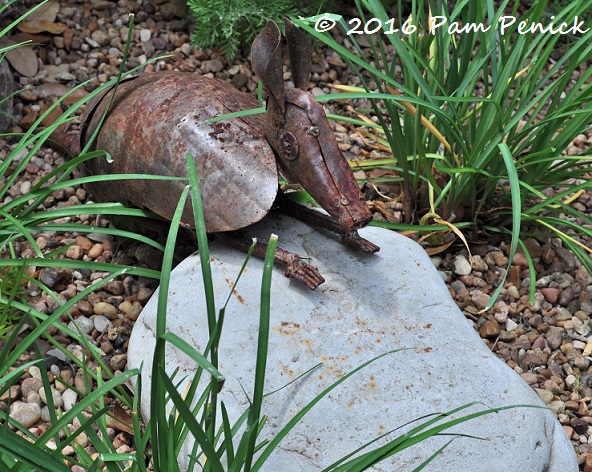
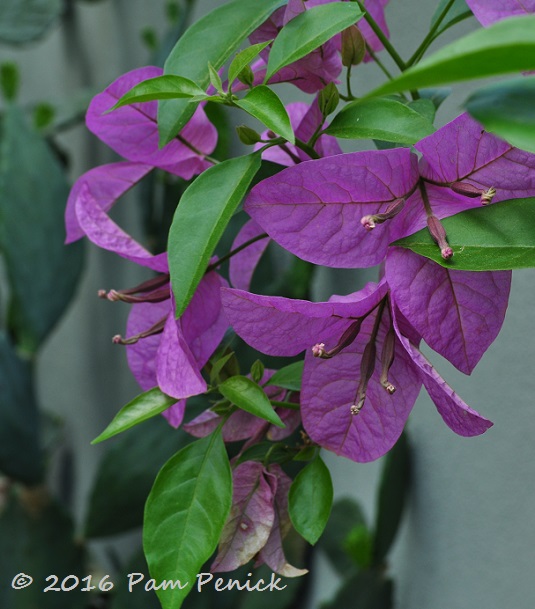
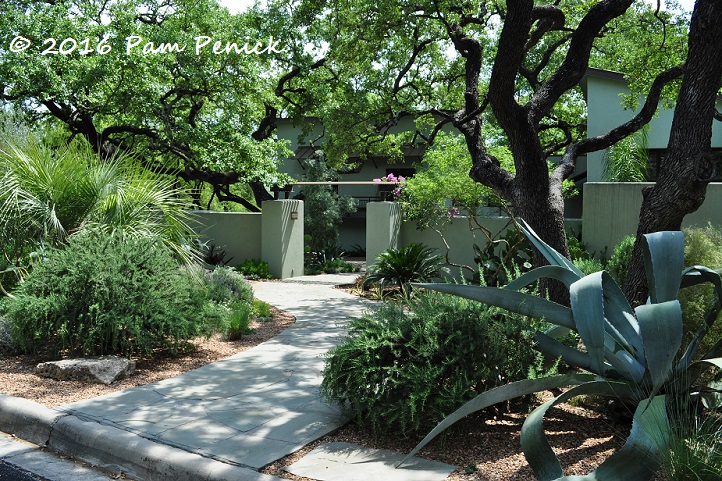
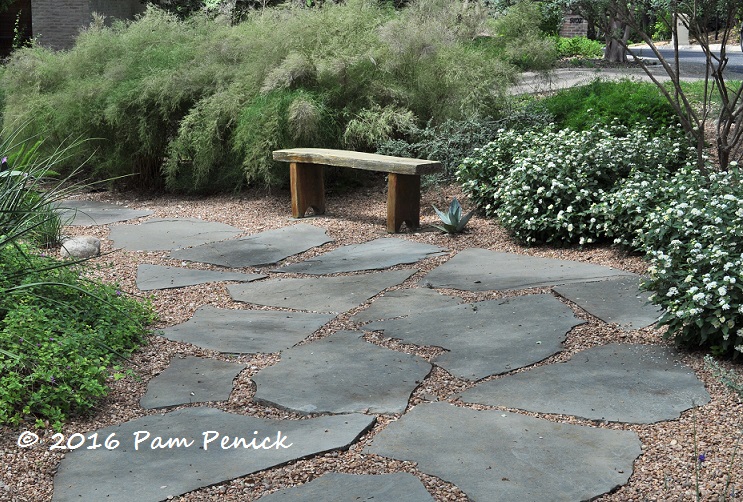
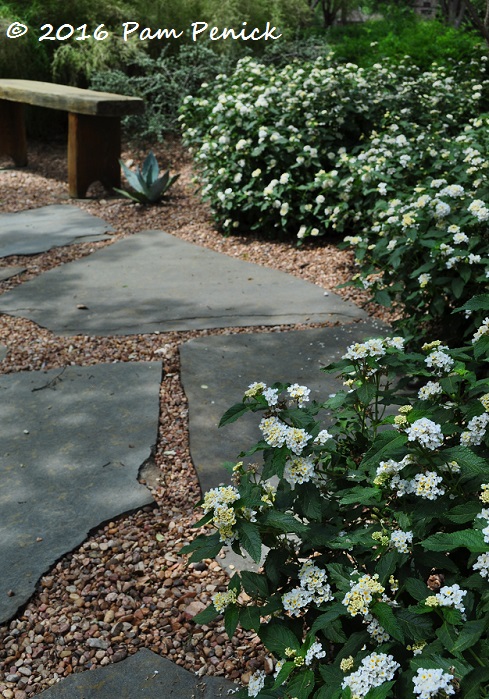
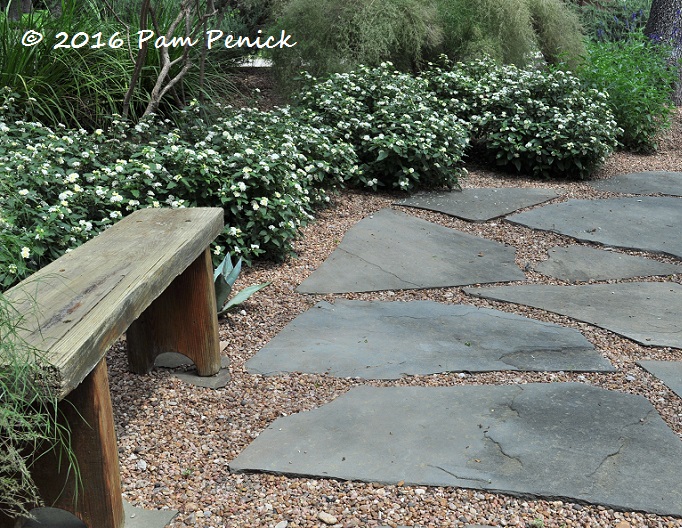
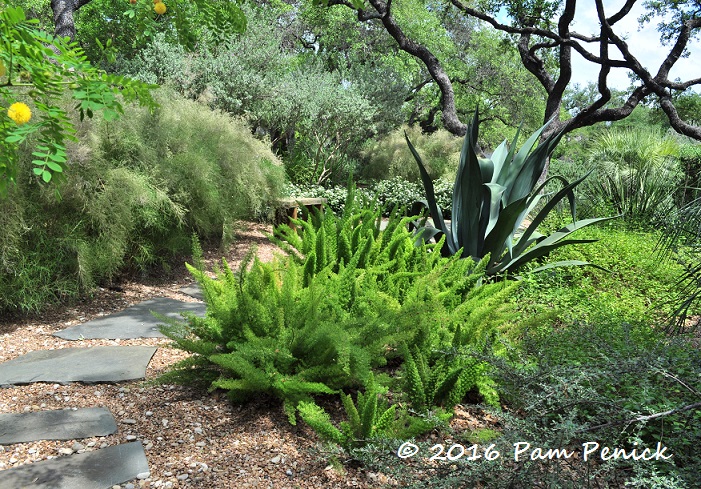
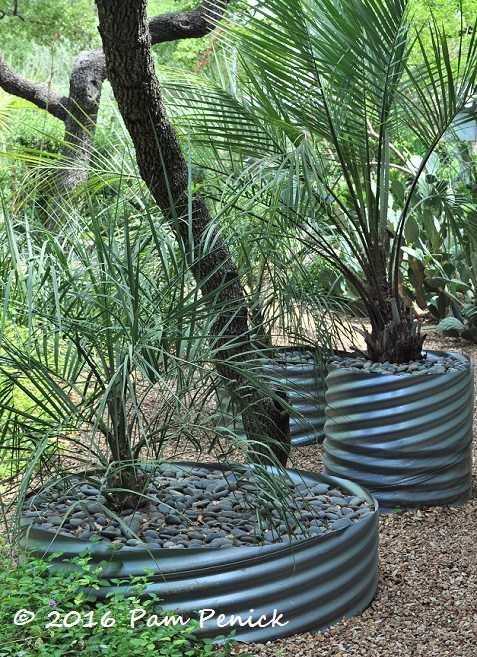
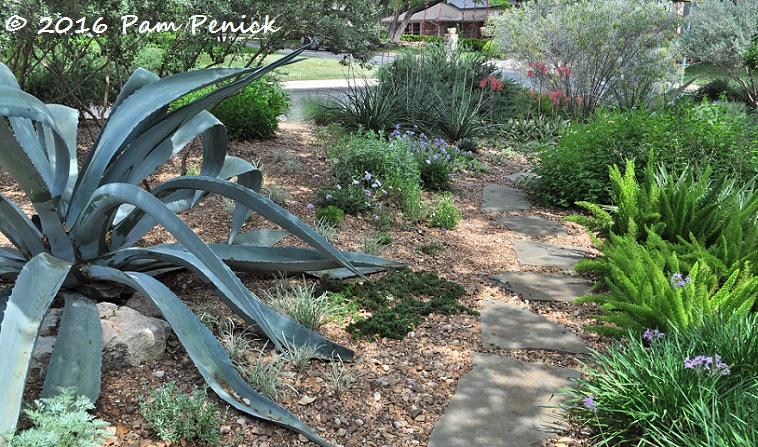
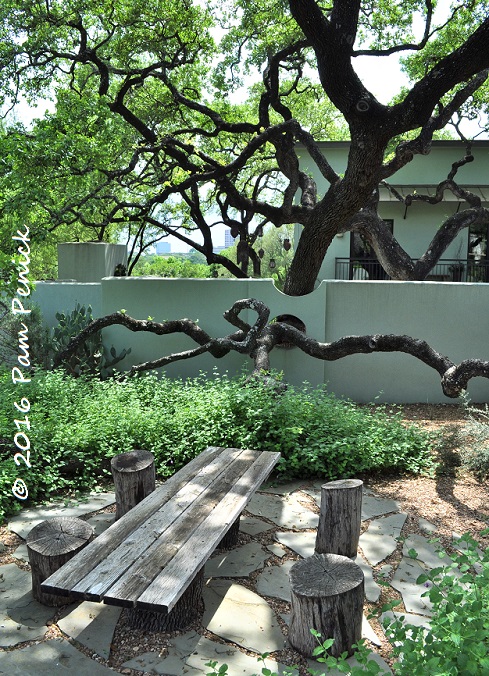
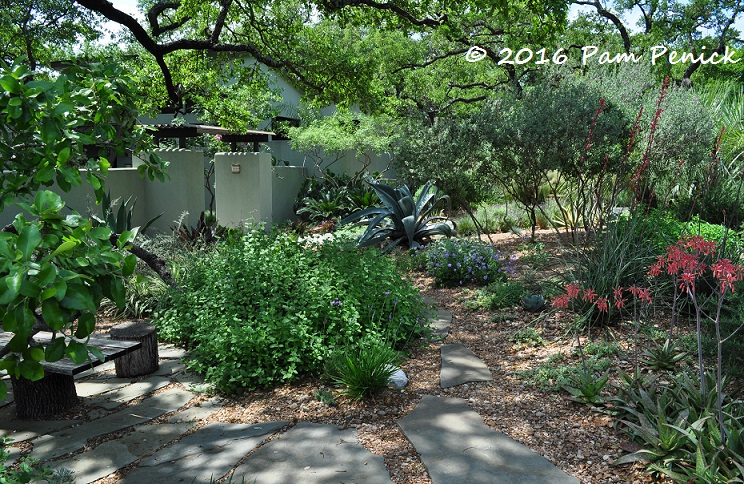
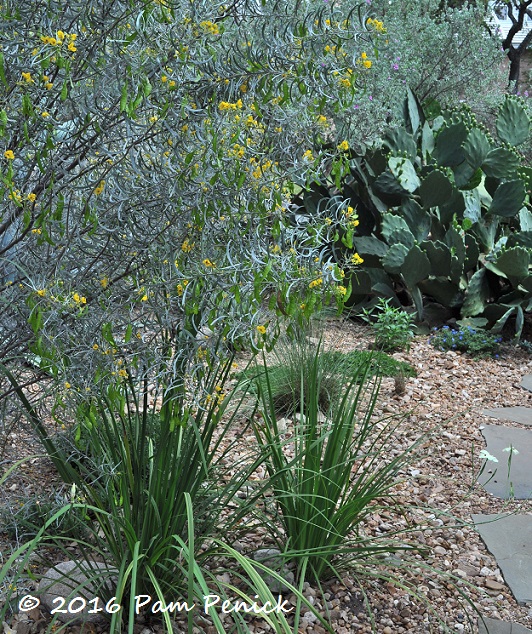
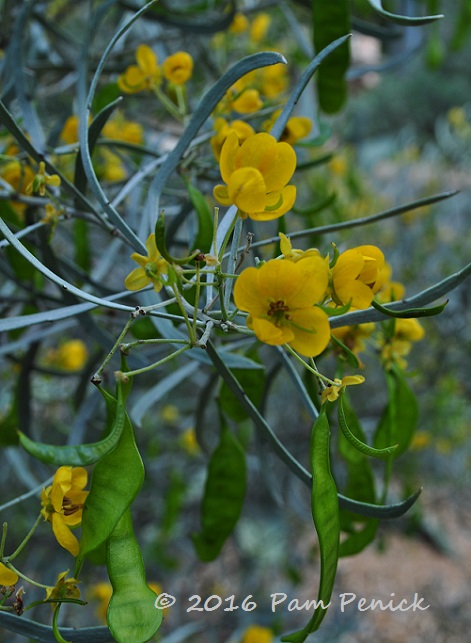
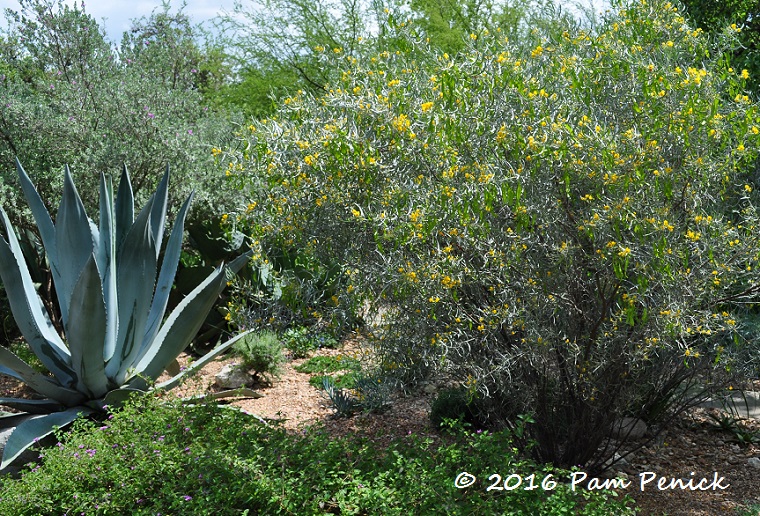
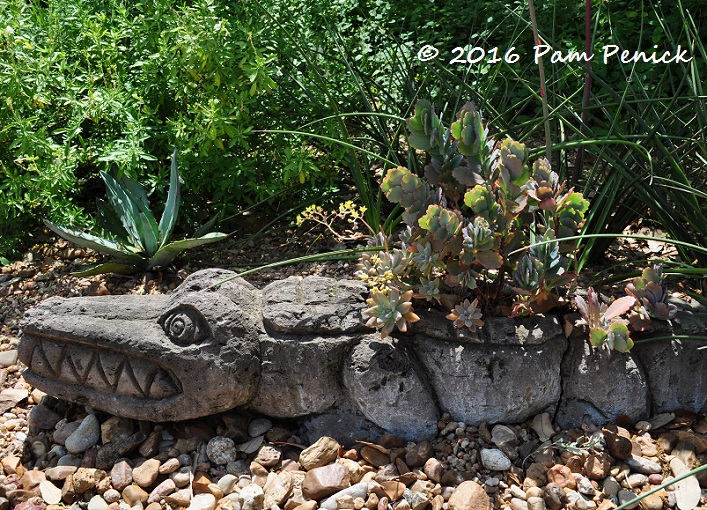
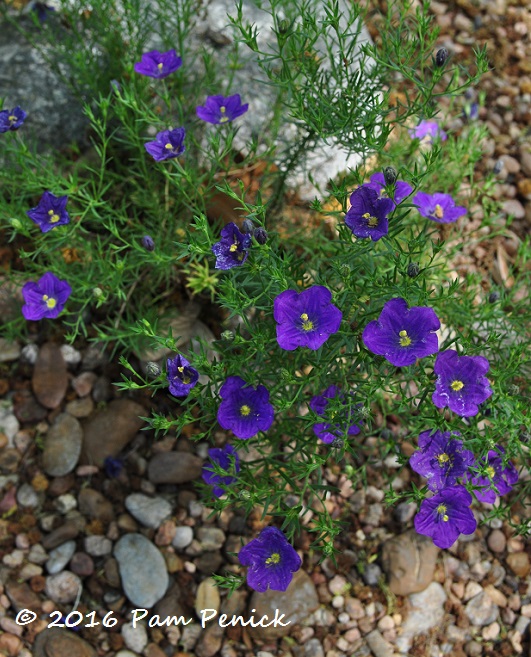
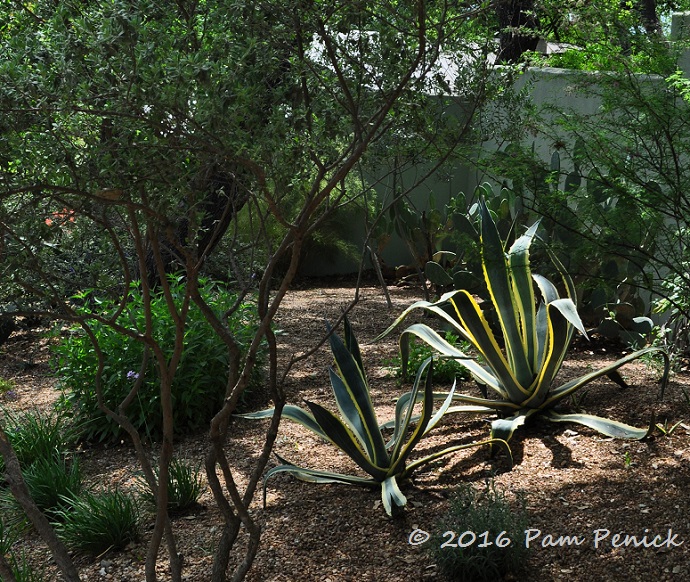
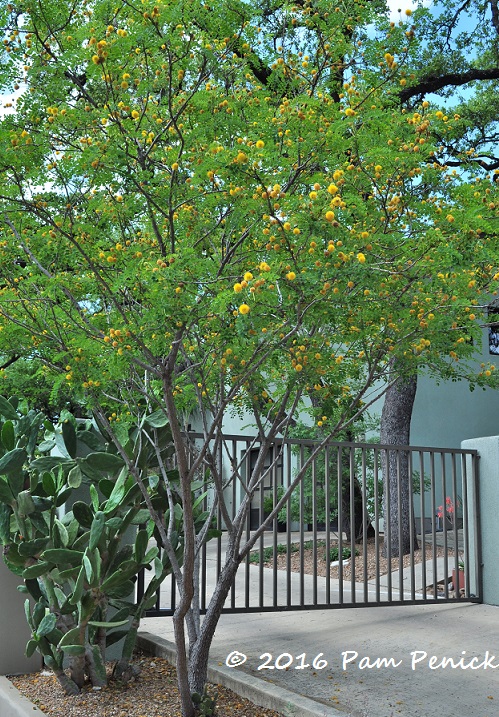
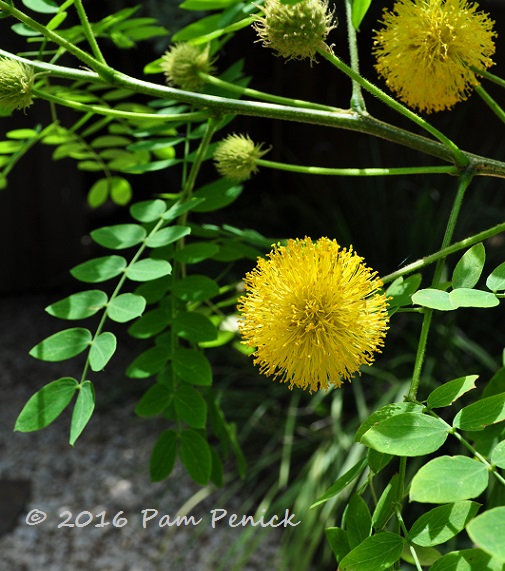
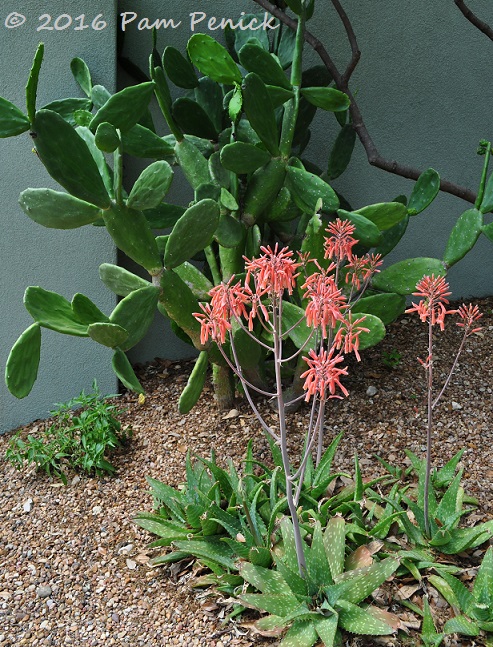
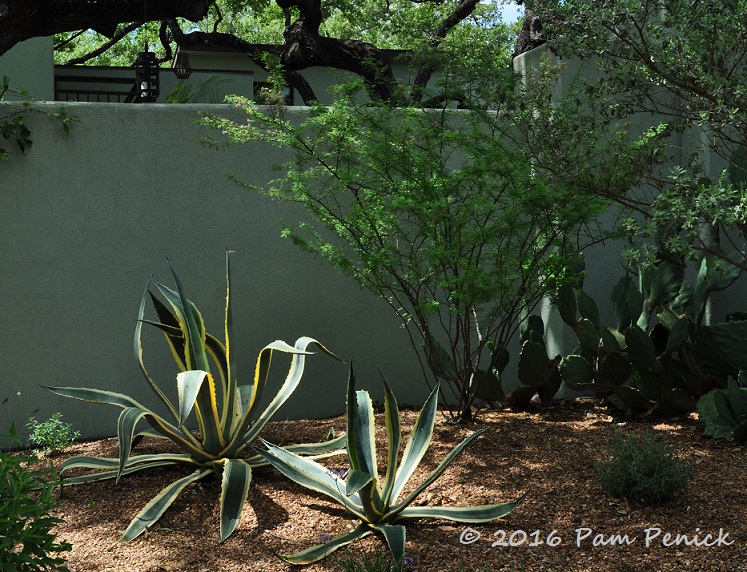
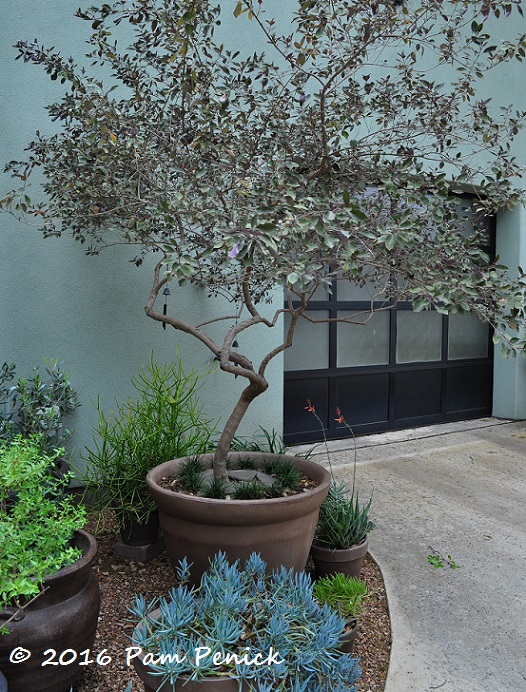
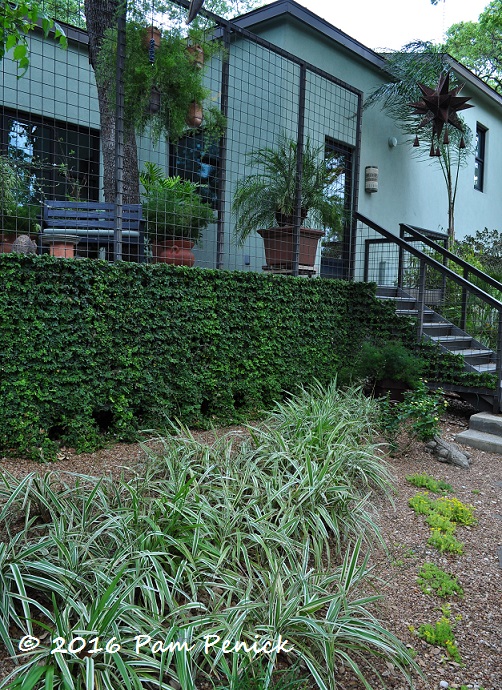
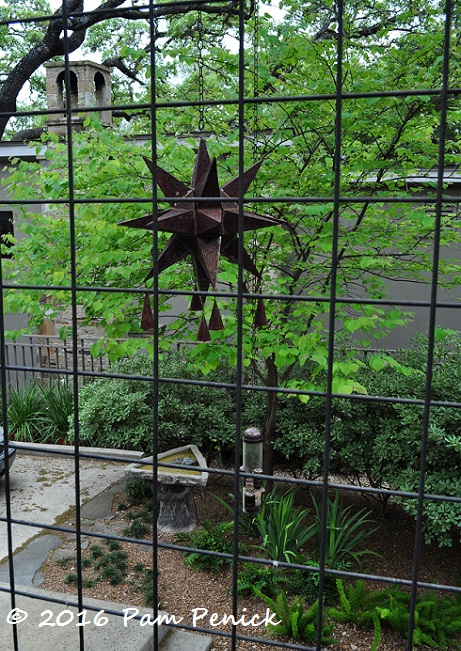
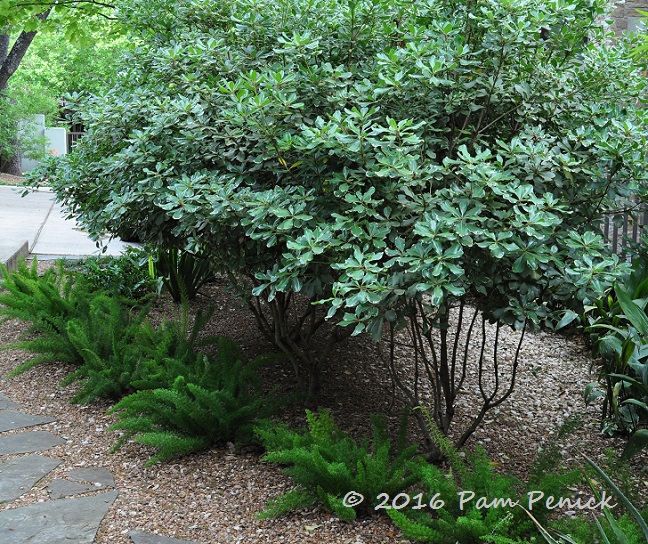
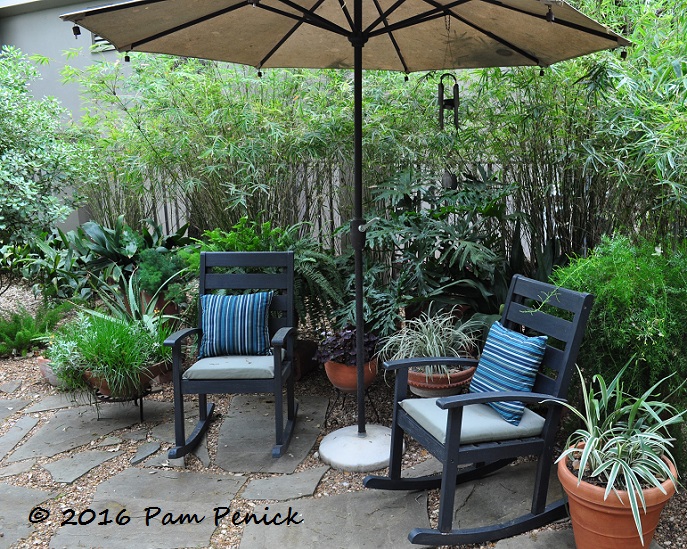
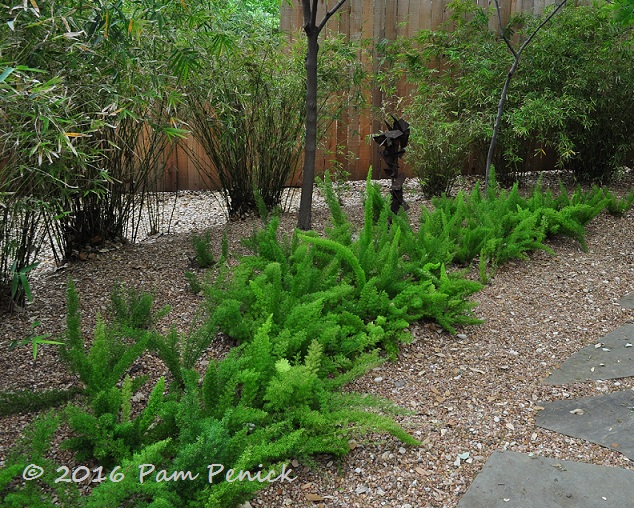
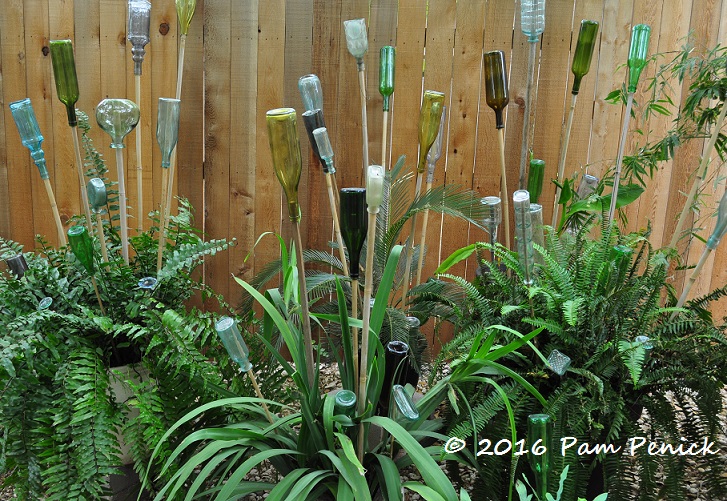
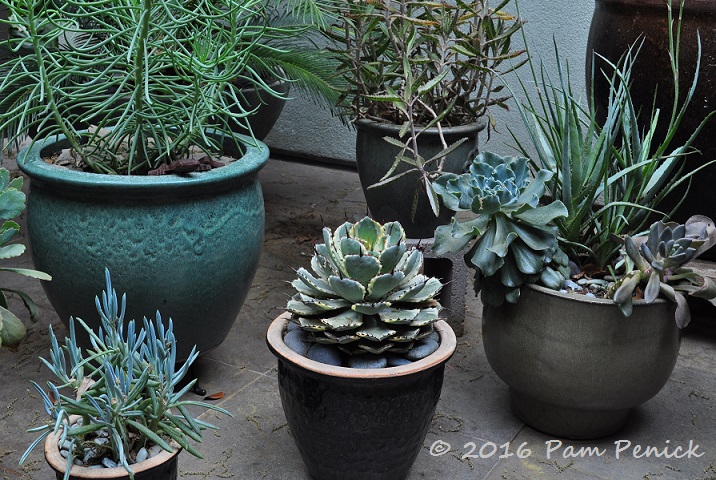
Great post as always. I believe the mystery flowers are Nuremberg. I love this garden.
Oops spell that nierembergia
Thank you, Gretchen! You’re absolutely right. —Pam
What a beautiful home and garden! I’m going to try that hanging asparagus fern idea for screening at the carport.
PS Our Agave parryi is “flowering” exactly like your Moby, so it opens up the possibility for something different, or maybe Parryi 2 at our front corner. It’s fun to think about making spots more attractive in the evolution of the garden.
Have fun thinking about what comes next, Tom. —Pam
What a wonderful garden. Lead me to the hammock. I would like to lie there and listen to the rock river, the hippos sleuthing through the garden. That Croc must have eaten those succulents sprouting from his back which are making him smile. A perfectly lovely place. Lucky you to get to go to tea there.
Yes, lucky indeed. I’m glad you enjoyed the tour, Lisa. —Pam
I wanted to comment earlier today but got my giant swollen head stuck in the doorway & couldn’t squeeze through until now!
thanks, pam, for again making the garden look so wonderful: your photos are just gorgeous as always – that bougainvillea close-up!
as to mystery plants, yes, that is Nierembergia scoparia ‘Purple Robe’ (which I lazily refer to as cupflower) but the strappy plant with the ferns & bottles is not agapanthus but Neomarica caerulea ‘Regina’ (Regina Blue Walking Iris or Giant Apostle’s Iris)…I wish you could have seen it in bloom, as it’s quite striking, but I actually chose it for the big evergreen foliage…now that you’ve mentioned agapanthus, however, I feel a nursery trip coming on! 🙂
thanks again for ALL your terrific & intelligent posts…tea will always be waiting whenever you want to visit again & re-bolster my ego!
Linda, thanks for the plant IDs. I Googled pics of the Regina iris, and wow, it does look like a beauty. I had such a good time at your beautiful home and garden, and the tea was scrumptious. Thanks again for a lovely afternoon! —Pam
Predominately green gardens are always so restful, even when a lot of the greenery is spikey. One day I’ll overcome my flower fixation and learn to focus on the space as a whole.
Oh, I think you’re already doing that quite successfully, Kris. Your garden is beautifully designed. —Pam
Wow, how come I’ve never seen a tobira pittosporum with a raised canopy before? Genius!
What surprised me even more was the rosemary with a raised skirt, Saurs. It was brilliant. You can find a picture in my earlier post about Linda’s garden. —Pam
Wow, I didn’t even notice that last time (despite the fact that you praised it!). That is smart pruning. I wonder if that method will stave off woodiness a little while longer than one would employing a more traditional, shearing job.
Clearly, I’m in a wow-y kind of mood when it comes to this garden because I did that twice in a row now.
saurs: first, thanks for the wows – one can never have too many!
second, don’t know where you garden, so who knows if what works for me here would work for you, but I can say that when I “underprune” the rosemary what I take off is generally quite woody with only scraggly tips of green…I try to lift everything up around the edges just above ground & then clear out any ugly deadwood up inside…you get sort of a vacant dome thing happening which lets air circulate, lets rakes & blowers get underneath, & gets rid of skunk ambush places (fill in the blanks about that!)
a master gardener here once told me that rosemary in our area usually needs to be replaced every 5 years or so because of excessive woodiness, etc., but mine were put in the ground from one-gallon pots in spring 2009, so maybe the underpruning helps?…of course, now that i’ve said that, I’ve probably jinxed them & tomorrow I will wake to brown clumps everywhere…
anyway, there you are for what it’s worth.
So relaxing and cooling, Linda’s garden is a wonderful place to spend time and you’ve shared so many great details of just how her garden works. The afternoon was even more special with tea and a group of friends who share an appreciation of the garden.
I keep thinking I should try limbing up shrubs and then the maintenance issue sinks in. They do look great that way.
Surely it would be only once or twice a year for shrubs like pittosporum? I’m going to be thinking of this technique whenever my garden starts feeling overgrown or “close.” —Pam
rest assured that the maintenance is not that bad, depending on the season, the age of the shrub, and how obsessive-compulsive you are…yes, once or twice a year will pretty much do it, possibly more for cenizos, and the tendency to sucker seems to diminish with age…the neighbors will probably point & laugh as you worm your way under the bushes, but raking and blowing will be SO much easier afterwards.
This info is helpful, Linda. Thanks for sharing. —Pam
This is a gardener who is a true artist and you have chronicled it so well that I almost feel as if I’ve been there (missed the tea, though). It must be rewarding for her to read your account. I’ve long admired that limbing-up technique for things like Rhodys and Camelias that can be “heavy” if left to their own devices. Mike has done it masterfully with the Rhododendrons around the house at Joy Creek.
She definitely has an artist’s eye, Ricki, and no wonder: both her parents were artists. Their art hangs throughout her house. She paints with plants — and her home decor, which is equally lovely. —Pam
The color restraint in this garden really does result in a truly peaceful atmosphere– one of my favorite gardens to be featured on your blog! The house color is an absolutely perfect compliment as well!! If only I had an eye for color 🙂 Thank you so much for sharing this garden tour with us Pam
You are very welcome, Lauren. I’m so glad you enjoyed this garden as much as I do! —Pam